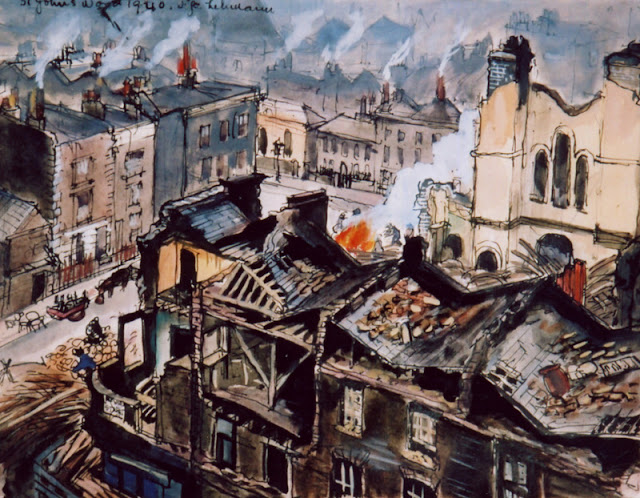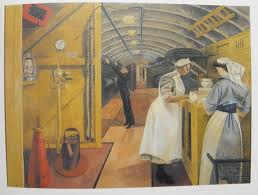Who Were the Women War Artists in Britain During WWII?
During the Second World War, there was a special department set up to employ artists to document the war. Following a call for artists that was broadcast through a BBC radio announcement, 37 artists were commissioned to become official war artists, through the 'WAAC' programme. A War Artists Advisory Committee, formed within the Ministry of Information, by one of Winston Churchill's parliamentary secretaries, Harold MacMillan and Sir Kenneth Clark. It was established on 16th November, 1939.

Of the 37 artists who were approved by the WAAC to be official war artists and employed on both full-time and part-time contracts, initially, only 4 of those were women. This was at a time when over 70% of artists were unemployed.
Those first 4 women were Essex born watercolour specialist Dorothy Josephine Coke (1897-1979) who studied under Sir Henry Tonks at The Slade School of Art and painted women mechanics during WWII, Evelyn Dunbar (1906-1960) who was paid a salary to document the land girls, Evelyn Gibbs (1905-1991) who studied at Liverpool School of Art and the Royal College of Art. She founded the Midlands Group of Artists in 1943 and her work is held by the Imperial War Museum. Ethel Gabain (1883-1950) painted A Child Bomb Victim Receiving Penicillin during WWII as well as painting Alexander Fleming in the laboratory where he had discovered the drug.
Architect Jane Drew (1911-1966) who was the only woman on the Architectural Design Council, designed air-raid shelters for the East End of London and also worked out schemes for home defence for the ARP (Air Raids Precautions Department), including a patented device for blackout ventilation of windows.
According to an article published in the Evening News in December 1939, artist Marjorie Morrison was the first woman to be engaged to design a mural for an Air Raid Precaution hoarding that was already in position. This photograph shows her at work painting boards to hide the entrance to The Building Centre in Bond Street, London.

Olga Lehmann (1912-2001) also a graduate of Slade School of Art was working as a portrait and mural artist and gave up her private commissions; painting murals in homes, businesses and on luxury ocean liners once the war broke out. Wanting to be part of the war effort, she requested and received a sketching permit from the Ministry of Information. Lehmann was one of only another 8 females that were granted the role of official war artist and suddenly found themselves creating art in a wide range of circumstances, in the middle of war.
Collaborating with Architect Jane Drew, they planned murals to help boost morale of the public, by brightening up main thoroughfare areas of Regent Street, where closed-down shops looked grim due to the ugly sandbags in front of them. As of February 2nd, 1940 these murals had not been executed due to the soaring cost of wooden boards for the hoardings.
Then in May 1940 'The War As I See It' exhibition was opened by the curator, art and fashion historian and writer James Lever (1899-1975) at The British Art Centre, The Stafford Gallery in St.James Place, London SW1. Showing over 100 war paintings from a variety of contemporary artists including the well-known French illustrator Mariette Lydis, British lyrical painter Margaret Thomas (1916-2016) is another artist who had initially studied at the Slade before furthering her education at the Royal Academy.
For the official WAAC commissions, many of the subjects that appointed women war artists covered were from the Home Front, featuring Royal Ordnance Factories (such as munition factory workers), voluntary services such as the WVS (Women's Voluntary Service), farming/agriculture, nurses and child evacuees.
Ethel Gabain in her wonderfully detailed prints, showed children at a railway station being evacuated to the countryside from Southend-on-Sea on 2nd June 1940. The children are clutching their necessary supplies and unaware of what their onward journey might bring.
Another of her lithographs was of women in the St Pancras area who were salvage-workers on demolition sites brick sorting and chipping during the Blitz of 1941. She was a well-respected French-Scottish print-maker who had also studied at the Slade School of Art in London. Her commissions through the WAAC included documenting the work of the WVS (Women's Voluntary Services), child evacuees and women working in industries such as agriculture and medicine. Some 38 of Gabain's war-time lithographic artworks are held in the WAAC collection at the Imperial War Museum.

Tedious but essential hard graft for Islington Borough Council.
Going against the grain of the kind of work they would usually doing.
Women Filling Sandbags. Lithographic Print by Ethel Gabain.
Much of the labour that was documented by Women War Artists was in industries relating to what would usually be considered a man's world, such as the underground factory in Corsham, near Bath, illustrated by Olga Lehmann, where women were making Bristol Centaurus engines for Hawker Tempest warplanes.

Painting by Olga Lehmann, who was also commissioned to create murals at the underground factory with the aim of brightening up the canteen areas for workers who very rarely saw the light of day.
Dame Laura Knight was commissioned to create a recruitment poster for the re-establishment of the WLA (Women's Land Army) that had first been established during WWI to recruit women, initially as volunteers, as many of the male agriculture workers had signed up for the armed forces.
 |
| Land Girls Ploughing. c1941. Oil on Canvas by Evelyn Dunbar. |
Around 17 paintings and studies by Dame Laura Knight were exhibited between the National Gallery and the Royal Academy during the war. 'Girl Power' was a feature of her paintings as can be seen in the intense focus to her work being given by factory worker Ruby Loftus. This famous painting from 1943 'went viral' as we would say today and was reproduced in newspapers and magazines around the world.
 |
| Ruby Loftus Screwing a Breech Ring by Dame Laura Knight |
In the painting that follows, Corporal Daphne Pearson of the WAAF (Women's Auxiliary Air Force) was painted by Laura Knight with a gas mask in her hand. In actuality, for the portrait sitting, the subject was insistent on holding a rifle, however, this was against regulations and was therefore not permitted to be shown. This is why Corporal Daphne Pearson looks like she has braced herself ready for battle in this painting.

Corporal Daphne Pearson painted by Dame Laura Knight
The Devastation Was Real

'This is War As I See It' that took place in central London in April 1940.
Progress, the central figure in this satirical artwork by Olga Lehmann holds a torch representing education. There are bomber planes swirling around, as well as barrage balloons and devastating scenes of the Blitz, including a church on fire, firemen wearing gas masks and injured civilians fleeing the scene. Some of Olga Lehmann's WWII paintings are in the collection of the Victoria & Albert Museum in London.
Olga Lehmann painted several scenes of the impact of the Blitz on London, including this one of the St John's Wood area after an air raid in 1940.
Evelyn Dunbar, one of the approved women war artists was tasked in 1941, during the London Blitz to paint scenes of hospital trains, including a goods wagon, converted into makeshift wards. Carriages belonged to the London and North East Railway. Her paintings are held in the Imperial War Museum.
Hospital Train by Evelyn Dunbar
A Bit of Light Relief for Air Raid Precautions Wardens
On August 20th, 1940 Olga Lehmann became the first mural artist to have been appointed by Air Raid Precautions to create a mural to decorate their headquarters. Her murals were unveiled by Mr Harold Scott, Chief Administrative Officer of the London Civil Defence Region.One of a series of murals painted at the ARP Headquarters by
Olga Lehmann. 1940.
Thank God It's Christmas!
Even during WWII there were Christmas celebrations. This painting by Olga Lehmann shows Christmas in the church crypt at St John's Wood which served as an air raid shelter during the London Blitz.This painting of burning Bergen-Belsen is held in the British Red Cross Museum and there are also other paintings by Zinkeisen documenting relief work that the charity carried out in the camp where it is thought that over 50,000 human beings perished. Those that the Nazi regime did not believe should live for whatever reasons including their religion, the Jews, their way of life, the Roma Gypsies, their sexual preferences, Homosexuals, Czechs, non- Jewish Poles and those with anti-Nazi political beliefs.

November 11th. Armistice Day of Remembrance
Today as I write this blog, is November 11th. Armistice Day for those killed during WW1. The official day of remembrance as it marks the ending of WWI. This day is a reminder, not only of WWI but of all wars and of all those affected by war, wherever they are in the world. May peace prevail.
Thank you for reading. I hope you found this of interest and will continue to promote the work of those often over-looked women artists of Herstory.
Poppy Dress Window Display for the Royal British Legion Poppy Appeal
Fundraising Campaign. Created by Mandie Stone. 2015
https://busheymuseum.org/artists-ethel-gabain
https://www.iwm.org.uk/history/what-was-the-womens-land-army
https://www.stjohnswoodmemories.org.uk
https://the-past.com/review/the-wartime-art-of-laura-knight
www.redcross.co.uk
www.annefrank.org










